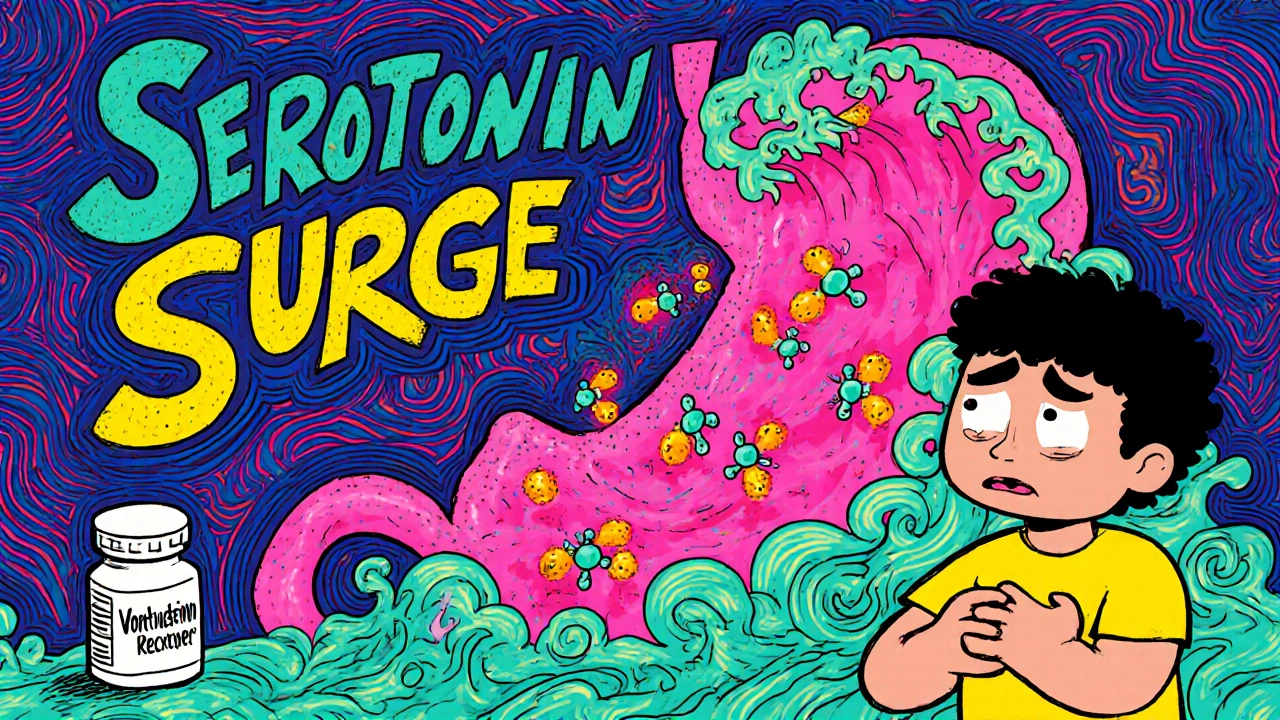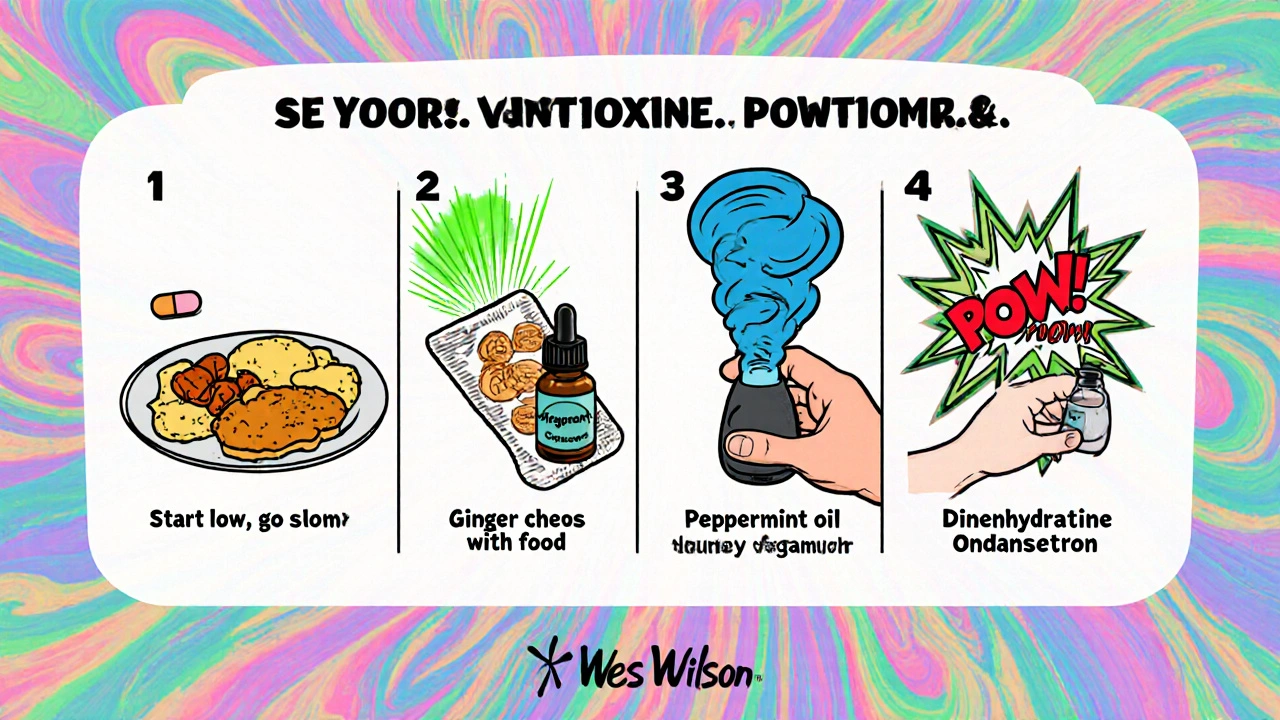
Vortioxetine Nausea Risk Calculator
Your Vortioxetine Dose
Additional Factors
Estimated Nausea Risk
Take 5 mg daily for 7-10 days, then increase dose. Always take with food and consider ginger supplementation.
Key Factors Influencing Your Risk
At 10 mg dose, nausea risk is 26% (vs. 8% placebo). Taking with food can reduce risk by approximately 34 percentage points based on clinical evidence.
When doctors talk about the newest antidepressants, vortioxetine is a multimodal serotonin modulator approved for major depressive disorder that also targets cognitive symptoms. The catch? Up to a third of patients feel nausea in the first week, which can make sticking to the medication feel impossible. Below you’ll find the science behind the upset stomach, proven tricks to tame it, and clear signs that you need a clinician’s input.
Why Vortioxetine Often Triggers Nausea
Vortioxetine works by boosting serotonin across the brain and gut. While it blocks several serotonin receptors (5‑HT1A, 5‑HT1B, 5‑HT7), it also inhibits the serotonin re‑uptake transporter, flooding the gastrointestinal tract with serotonin. The excess activates 5‑HT3 receptors on the stomach lining, which is the classic trigger for nausea and vomiting.
Clinical trials show a clear dose‑response curve: 15 % nausea at 5 mg, 26 % at 10 mg, and 29 % at 20 mg per day, versus only 8 % with placebo. Most cases appear within the first three to seven days and usually fade by the second week as the body adapts.
Step‑by‑Step Plan to Reduce Nausea
- Start low, go slow. Begin with 5 mg daily for the first 7‑10 days. Studies from the ECNP guidelines report a 40 % drop in early discontinuations when this titration is used.
- Take it with food. A Cleveland Clinic observation found 63 % of patients felt less nausea when the pill was swallowed with a full meal rather than on an empty stomach.
- Ginger supplementation. One gram of powdered ginger each day cut nausea scores by 44 % on a visual analog scale in a 2021 trial.
- Peppermint aromatherapy. Diffusing peppermint oil reduced daily nausea episodes by an average of 3.2 per week.
- Avoid fatty or overly spicy meals. Such foods can worsen gastric discomfort and amplify serotonin‑driven signals.
- OTC anti‑emetics as needed. Dimenhydrinate 25‑50 mg taken when nausea spikes works for roughly 78 % of users.
- Prescription rescue. If OTC relief fails, ondansetron 4 mg twice daily has an 89 % success rate; prochlorperazine is reserved for refractory cases.
Remember to keep a medication diary - note the time you take vortioxetine, what you ate, and any nausea intensity. Patterns often emerge that help you fine‑tune the approach.
When to Call Your Doctor
Most nausea resolves within two weeks, but you should seek professional advice if any of the following occur:
- Vomiting persists for more than 48 hours.
- Weight loss exceeds 5 % of your baseline body weight.
- Severe dehydration signs (dry mouth, dizziness, dark urine).
- New‑onset severe abdominal pain or diarrhea.
In those situations, a clinician may adjust the dose, switch to an extended‑release formulation, or consider a different antidepressant altogether.

Comparing Nausea Across Common Antidepressants
| Medication | Typical Dose | Nausea Rate | Key Advantage |
|---|---|---|---|
| Vortioxetine | 5‑20 mg/day | 15‑29 % | Cognitive symptom improvement |
| Sertraline (SSRI) | 50‑200 mg/day | 23‑25 % | Well‑studied, low cost |
| Duloxetine (SNRI) | 30‑60 mg/day | 22‑27 % | Pain‑relief benefits |
| Vilazodone | 20‑40 mg/day | 13‑18 % | Lower sexual side‑effects |
Note that while vortioxetine’s nausea rates sit in the same ballpark as sertraline at higher doses, its multimodal action often means milder severity for many patients. The trade‑off is the higher early discontinuation risk, especially if a rapid titration is used.
Pharmacogenetics: The CYP2D6 Connection
Vortioxetine is metabolized primarily by the CYP2D6 enzyme. Poor metabolizers can experience up to a 2.4‑fold rise in drug exposure, which translates into a 62 % higher nausea risk when combined with strong CYP2D6 inhibitors like fluoxetine. If you’re on a CYP2D6‑inhibiting drug, your prescriber may order a genetic test or simply stick to the 5 mg start‑up dose for a longer period.
What If Nausea Won’t Go Away?
Approximately 6 % of patients stop vortioxetine because the nausea never subsides. In those cases, clinicians consider two pathways:
- Switch to an extended‑release version under development - phase‑2 data showed a drop from 28.4 % to 16.7 % nausea incidence.
- Transition to another antidepressant with a more favorable GI profile (e.g., bupropion or mirtazapine), especially if cognitive benefits are less critical.
Both options should be discussed in the context of your overall treatment goals.
Real‑World Voices: Patient Stories
On Reddit’s r/antidepressants community, a 2022 analysis of 1,247 posts found that 68 % of users mentioning vortioxetine also talked about nausea. One commenter wrote: “Started Trintellix 10 mg, threw up twice the first week. My doctor told me to take 5 mg with breakfast for two weeks, then increase. By week 3 the nausea was manageable with ginger chews.” Similar patterns echo on GoodRx reviews, where 62 % of negative comments point to persistent nausea, while 28 % of positive reviews praise the drug’s mood‑lifting effect once the stomach settles.
Quick Reference Checklist
- Begin at 5 mg daily for 7‑10 days.
- Take with a full meal.
- Try ginger (1 g) or peppermint oil.
- Have dimenhydrinate on hand; move to ondansetron if needed.
- Avoid strong CYP2D6 inhibitors unless dose is lowered.
- Contact your doctor if vomiting >48 h, weight loss >5 %, or severe abdominal pain.
How long does vortex‑induced nausea usually last?
Most patients report that nausea improves within 9‑16 days, with about 74 % seeing full resolution by the end of the second week.
Is it safe to take vortioxetine with food?
Yes. Taking the medication with a full meal reduces the incidence of nausea from roughly 63 % to 29 % in observational studies.
Can I use over‑the‑counter anti‑nausea meds?
Dimenhydrinate 25‑50 mg taken as needed works for about three‑quarters of patients. If it fails, a prescription ondansetron 4 mg twice daily is highly effective.
Should I worry about drug interactions?
Avoid strong CYP2D6 inhibitors such as fluoxetine or paroxetine unless your dose is lowered, because they can raise vortioxetine levels and worsen nausea.
When is it time to switch medications?
If nausea persists beyond three weeks despite diet, timing, and anti‑emetics, discuss alternative antidepressants with your clinician. Around 6 % of patients discontinue for this reason.

![Quibron‑T (Theophylline) Uses, Dosage, Side Effects, Interactions [2025 Guide]](/uploads/2025/09/thumbnail-quibron-t-theophylline-uses-dosage-side-effects-interactions-2025-guide.webp)




Johnae Council
October 26, 2025 AT 14:23Look, the ginger thing sounds nice until you realize most studies used powdered extract, not those cheap candy chews you find at the pharmacy. If you go over a gram a day you might start feeling a bit of heartburn yourself, which defeats the purpose of calming the stomach. Also, taking Vortioxetine with a huge breakfast can slow absorption and make the peak serotonin surge less predictable. Bottom line: start low, keep the ginger real, and monitor any extra GI irritation.
Manoj Kumar
October 26, 2025 AT 15:23Ah, the age‑old dance of serotonin and the gut – like trying to keep a philosophical debate quiet in a library. It’s funny how a molecule meant to lift mood ends up turning your stomach into a karaoke bar for 5‑HT3 receptors. But hey, if you treat the nausea as a fleeting existential crisis, you might just ride it out with a smile and a dash of peppermint oil. Remember, the body’s adaptation is the universe’s way of saying, ‘I’m still here, let’s keep going.’
Hershel Lilly
October 26, 2025 AT 16:23Agreed, starting at 5 mg and pairing the dose with a balanced meal often smooths the transition. I’ve found noting the exact time of dosing helps spot patterns when the nausea spikes.
Kasey Marshall
October 26, 2025 AT 17:23Take it with a solid breakfast avoid greasy sauces keep ginger on hand.
Paul Luxford
October 26, 2025 AT 18:23Respectfully, if you’re also on fluoxetine or another strong CYP2D6 inhibitor, ask your doctor about a genetic test or simply stay at the 5 mg dose longer before titrating up.
Nic Floyd
October 26, 2025 AT 19:23From a pharmacodynamic perspective, Vortioxetine’s multimodal activity engages the serotonergic cascade at several nodal points – it’s not merely a reuptake inhibitor. The drug’s affinity for 5‑HT1A autoreceptors modulates presynaptic serotonin release, while antagonism at 5‑HT3 receptors theoretically mitigates some nausea, yet the net effect depends on gut–brain axis signaling density. Meanwhile, CYP2D6 polymorphisms introduce a pharmacokinetic variance that can amplify plasma concentrations up to 2.4‑fold in poor metabolizers, translating into a statistically significant rise in GI adverse events. Clinical pharmacology literature highlights that co‑administration with potent CYP2D6 inhibitors-think fluoxetine or paroxetine-necessitates dose adjustments, often reverting to the 5 mg initiation tier for an extended 2‑3‑week window. 🧪 In practice, a therapeutic drug monitoring (TDM) approach, though not routinely performed for Vortioxetine, could provide a quantitative read‑out to inform tolerability thresholds. 🩺 Moreover, studies employing the Visual Analogue Scale (VAS) for nausea have documented a median reduction of 44 % when adjunctive ginger (1 g powdered) is introduced, reinforcing the synergy between phytochemicals and serotonergic modulation. 🌿 It’s also worth noting that the sensation of nausea is mediated not only by peripheral 5‑HT3 activation but also central chemoreceptor trigger zones, which are susceptible to desensitization after repeated exposure-a phenomenon that underlies the typical 7‑14‑day resolution window. For patients presenting with refractory nausea beyond the second week, escalation to a 5‑HT3 antagonist like ondansetron (4 mg BID) demonstrates an 89 % efficacy rate in randomized cohorts, surpassing over‑the‑counter antihistamines which hover around 70 % efficacy. 📈 Finally, when constructing a medication diary, logging variables such as macronutrient composition, time of day, and concurrent supplements (e.g., St. John’s Wort) can uncover hidden interaction patterns, guiding clinicians toward precision‑tuned dosing regimens. 🗒️ In summary, a holistic management plan that integrates pharmacogenetic screening, dietary adjuncts, and targeted anti‑emetics optimizes tolerability while preserving Vortioxetine’s cognitive benefits.
Dave Sykes
October 26, 2025 AT 20:23Listen up: if nausea is wrecking your day, don’t just ride it out. Grab some ginger, take your dose with a hearty breakfast, and keep a dimenhydrinate on standby. If that fails, step up to ondansetron-no shame in using a prescription when it works. And always flag persistent symptoms to your prescriber; the sooner you act, the quicker you get back to feeling like yourself.
Jacqui Bryant
October 26, 2025 AT 21:23Take it with food and it’ll feel better.